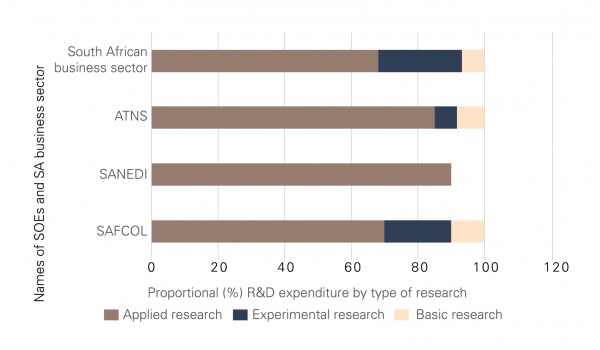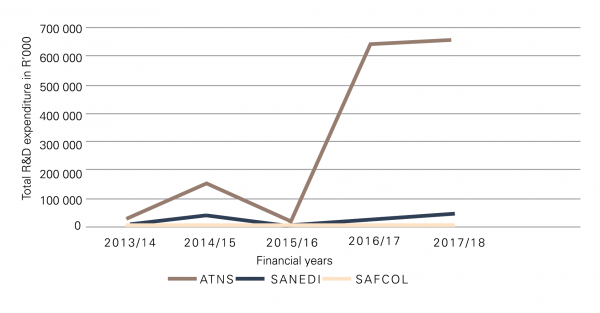Gearing up: R&D and innovation capabilities in three South African state-owned enterprises

Photo by Ben Jessop
SANEDI has R&D programmes dedicated to cleaner fossil fuels, smart grids, working for energy, data and knowledge management, cleaner transport, and renewable energy. Photo: Ben Jessop, Pexels
State-owned enterprises (SOEs) are an integral part of South Africa’s economic development. In recent years, there has been widespread public scrutiny concerning the public value of SOEs and their place in the economy. But what about their potential for generating new knowledge, delivering innovation and promoting economic transformation? Do SOEs have research, development and innovation capabilities and how can these be nurtured? The HSRC’s Centre for Science, Technology and Innovation Indicators (CeSTII) studied three of these enterprises to find out. By Jerry Mathekga
In a June 2021 edition of his weekly newsletter, President Cyril Ramaphosa wrote that ‘state-owned enterprises (SOEs) should be at the forefront of South Africa’s economic and social transformation’. This is because they provide infrastructure and services on which the economy depends, such as electricity, transport, freight logistics, water, and telecommunications, Ramaphosa argued. Such services also help to ensure that the basic needs of all South Africans, particularly the poor, can be met. But does this mean that SOEs are sufficiently geared to leverage research and development (R&D) and innovation to meet their mandates while supporting all citizens and fostering inclusive economic growth?
Using a case study approach, the HSRC’s Centre for Science, Technology and Innovation Indicators (CeSTII) explored how three SOEs – Air Traffic and Navigation Services (ATNS), the South African National Energy Development Institute (SANEDI) and South African Forestry Limited (SAFCOL) – were geared to perform R&D and innovation.
R&D and innovation in SOEs
A key finding was that ATNS, SANEDI and SAFCOL all have relatively well-established R&D programmes and teams. All three consistently reported spending more than 65% of their R&D budget on applied research (Figure 1), which the Organisation for Economic Cooperation and Development’s Frascati Manual 2015 describes as ‘original investigation undertaken to acquire new knowledge’. This research is directed at specific, practical aims. Moving beyond applied research, experimental development then draws on existing knowledge aimed at introducing new or improved products or processes. Researchers may also perform basic research, which may be more theoretical without any particular application in view – often the domain of universities researching fundamentally new knowledge.
ATNS conducted applied research focused on aviation and non-aviation technology, enabling the SOE to modify its existing equipment to suit its special requirements as well as its operational and environmental conditions. SANEDI’s R&D programmes focused on applied energy research and demonstration, with six sub-programmes dedicated to cleaner fossil fuels, smart grids, working for energy, data and knowledge management, cleaner transport, and renewable energy. SAFCOL’s R&D programmes were focused on aspects of the forestry business, mainly timber harvesting, processing, and related activities.
Figure 1: Proportional (%) R&D expenditure by type of research: SAFCOL, SANEDI, ATNS and South African business sector, 2017/18 and 2018/19
SOEs tend to perform applied research more than experimental development, when compared with the South African business sector (Figure 1). This is not too surprising because one function of SOEs is to support private-sector businesses through providing services rather than generate innovations in the form of artefacts through experimental development. The question is whether the governance requirements for SOE mandates are sufficiently flexible to allow them to focus on innovation as a key strategy. Typically, many SOEs have used R&D for infrastructure maintenance.
Three case studies
We found some quantitative evidence to support the argument that the three SOEs were well geared to perform R&D and innovation effectively. A common proxy used to indicate R&D activity is R&D expenditure, which is the sum of expenditure on R&D-relevant vehicles, plant, machinery and equipment; land, buildings and other structures; labour; and other current expenditure. The three SOEs’ expenditure on R&D has gradually increased over recent years, with ATNS significantly ramping up R&D activity in 2016/17 – see Figure 2.
Figure 2: Total R&D expenditure: ATNS, SANEDI and SAFCOL (R’000), 2013/14 to 2017/18
After considering the attributes of SOEs and the literature on innovation systems, we examined five qualitative dimensions of R&D and innovation: governance, human capability, technological capability, research infrastructure, and networking and collaboration.
Governance
As it was key to their respective businesses, the three SOEs reported continuous investment in R&D and innovation activities, which were investments incorporated in the innovation portfolios of each SOE’s executive structure. Sound strategies were also in place to promote, manage and execute R&D and innovation activities. For instance, SANEDI had reported a small but capable workforce driving its research and innovation, while SAFCOL illustrated how it had incorporated R&D and innovation within its executive structure and had made a strong effort to drive business revenue growth and efficiencies. ATNS strategically identified R&D and innovation as key drivers of growth. Its management promoted an R&D strategy to respond to the challenges that face the aviation industry in the context of the Fourth Industrial Revolution.
Human capabilities
All three SOEs employed a cohort of internal R&D personnel, ranging from technicians to researchers. Though maintaining in-house capacity to perform R&D remained a challenge, the SOEs overcame this through collaboration and training. ATNS had a training academy providing aviation-related and safety-related courses to its staff. SAFCOL worked with the University of Pretoria to build capacity in the field of forestry-related research and other forestry activities, and SANEDI had networks with universities and other organisations as part of capacity building in the engineering and IT fields, among others.
Technological capability
It was evident that, over time, the three SOEs had built technological capabilities within their respective areas of research and development. For example, ATNS’s technological capability building was characterised by capital investments in new air-navigation infrastructure sites (for example the control tower at King Shaka International Airport), technology acquisitions (high-frequency radio), systems for information and communication (NAFISAT), training programmes (AMDP), and collaborative networks. These investments, together with the human capacity developed to operationalise the associated technologies, represented a substantial track record of technological capability within the organisation.
SAFCOL had timber and non-timber technological capabilities. Its timber capabilities spanned the entire timber value chain, from genetic engineering and breeding to sawmilling and beneficiation of timber products. SAFCOL demonstrated substantial capabilities across the value chain. Its non-timber capabilities encompassed community-based forestry and cooperatives, training, and eco-tourism.
SANEDI’s technological capability in its research programme and project architecture included carbon capture; a utilisation and storage project; smart-grid projects to improve municipalities’ capacity to operate sustainable electricity distribution; financial models; and several community-focused renewable-energy initiatives targeting poor rural communities.
Research infrastructure
For all three SOEs, research infrastructure presented a challenge, though for different reasons. SAFCOL had a dedicated research centre with a research team, but ATNS and SANEDI only had research teams. To address gaps, the SOEs collaborated with different organisations and universities to access research infrastructure. There was, however, a need for more research infrastructure such as laboratories, demonstration equipment and software programs.
Networking and collaboration
While the three SOEs performed other functions in addition to R&D and innovation, the positive effects of their collaborations with universities and other organisations were evident. This suggests that efforts to promote collaboration could be valuable for other SOEs and help improve their R&D and innovation capabilities. Existing partnerships benefited the three SOEs by deepening the expertise in their respective sectors – energy for SANEDI, forestry for SAFCOL and aviation for ATNS. Furthermore, these partnerships provided research infrastructure, solving sector-specific problems, building capacity, and providing funding, among others.
Strengthening SOE R&D to contribute to inclusive economic growth
Many opportunities exist within South Africa’s SOEs to use R&D and innovation activities and capabilities to achieve their developmental and economic goals. It was evident that the three SOEs were gearing up to perform R&D and innovation more efficiently and effectively in the future. It was positive that all three enterprises demonstrated tangible efforts to improve their internal capabilities and strengthen collaboration and partnerships with complementary organisations to retain and build sustainable and effective R&D and innovation capabilities. More research in this vein could assist broader policy monitoring and evaluation efforts as part of broader SOE reform.
Research reports on SOEs
In 2017/18, CeSTII completed a research report commissioned by the Department of Science and Innovation entitled Research & Development Trends in State-owned Enterprises in South Africa: A Baseline Research Report. The findings were validated at a workshop, which suggested CeSTII further assess the R&D and innovation capabilities of South African SOEs. This was taken forward as a dedicated case-study research project. The reports from this project are now in preparation, with a report for each SOE studied and a synthesis report covering findings from the three SOEs. This article is based on the synthesis report.
Author: Jerry Mathekga is a senior researcher at the HSRC’s Centre for Science, Technology and Innovation Indicators. The research on which this article is based was a collaboration between Dr Nazeem Mustapha, Jerry Mathekga and Gerard Ralphs.


